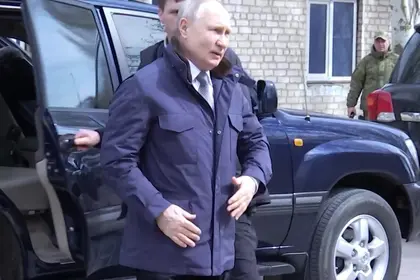In its backgrounder entitled the “Russian Offensive Campaign Assessment,” dated April 18, 2023 the US-based Institute for the Study of War (ISW) looked closely at the visit by Russian President Vladimir Putin, to the occupied Kherson and Luhansk regions, in an attempt to assess the wider implications.
The Kremlin announced, on April 18, that Putin visited the headquarters of the Russian Dnepr Group of Forces in Kherson Oblast and the Vostok National Guard headquarters in occupied Luhansk Oblast. Geolocated footage shows that Putin visited Arabat Spit in southwestern Kherson Oblast – at least 130 kilometers from the nearest front line.
JOIN US ON TELEGRAM
Follow our coverage of the war on the @Kyivpost_official.
Was he really there? And when?
The Kremlin video showed Putin apparently arriving by helicopter in Henichesk, a port city on the Sea of Azov. Later footage of Putin’s departure shows the Chonhar Hotel, which is on the border with Crimea, indicating that he only travelled by helicopter through Crimea but went to Kherson Oblast by car. Several helicopters are seen circling over the hotel as he left.
The Kremlin spokesman, Dmitry Peskov, claimed that Putin had visited the occupied territories on April 17. The original raw video footage included Putin making reference to the upcoming Orthodox Easter holiday, saying it was “coming up” in one of the videos, which suggests that the visit took place prior to Easter Sunday, April 16.

Trump’s Russia Plan – Will It Work? NATO, Putin & US Strategy Explained
This was later edited to exclude Putin’s statement and date it as later in an attempt to overshadow the visit by the Ukrainian President Volodymyr Zelensky to the Avdiivka front line on April 18.
It was previously reported that Russian milbloggers had criticized Russian officials for their failure to visit the front lines, unlike Zelensky. Putin’s March 19 visit to occupied Mariupol was interpreted as another attempt to portray himself as a wartime leader. Russian media sources feted Putin’s visit, which they claimed had boosted the morale of Russian troops preparing to repel Ukrainian counteroffensives.
Bulldogs under the rug?
Winston Churchill famously described Kremlin infighting as “bulldogs under the rug.” He said, “An outsider only hears the growling, and when he sees the bones fly out from beneath, it is obvious who won.”
Moscow may not be at that point, but it’s fast approaching.
Putin’s April visit, highlighted leadership changes among Russian forces. It was said that he received briefings from several Commanders including the head of Russian Airborne Forces (VDV), Col. Gen. Mikhail Teplinsky, head of the Dnepr Group of Forces, Col. Gen. Oleg Makarevich, and other unnamed military commanders regarding the situation along the Kherson and Zaporizhzhia front lines.
“Teplinsky is likely one of the few senior Russian generals widely respected by the rank-and-file,” the UK Ministry of Defence wrote on social media on Sunday.
Putin also met with Col. Gen. Alexander Lapin and other unnamed top-ranking officers to discuss the situation on the Luhansk front line. These commanders were likely singled out as being responsible for commanding the likely targets for any Ukrainian counteroffensive.
This has also been considered as the Kremlin identifying potential “scapegoats” for its domestic audience, in the event of another military failure. The meetings with Teplinsky, Makarevich and Lapin also seem to confirm not only a change in military command on the ground but also possibly within the Kremlin’s inner circle.
A Kremlin-affiliated milblogger characterized the absence of both the Defense Minister, Sergei Shoigu, or the Chief of the Russian General Staff, Valery Gerasimov from the visit as a conscious snub. He claimed that the reappointment of Teplinsky and Lapin had happened against the wishes of both Gerasimov and Shoigu.
Russian sources previously claimed that Teplinsky was replaced as VDV commander on Jan. 13, because he was too close to the head of the Wagner Group, Yevgeny Prigozhin. His reappointment suggests that, following the failure of Russia’s unsuccessful winter/spring offensive in Donbas, the Kremlin wants to work with Wagner to achieve victory in Bakhmut. It may further indicate that Prigozhin has regained Putin’s favor and has overridden Gerasimov and Shoigu’s efforts to eliminate Wagner in Bakhmut.[13]
At the same time Putin may be limiting Wagner’s influence by reappointing Lapin to command the Luhansk sector of the front line. Prigozhin and Chechen Leader Ramzan Kadyrov had led a successful campaign to remove Lapin from his previous position because of personal conflict.
The milblogger further speculated that Putin had reappointed Lapin, not only to reinforce command in the area, but also in an attempt by Putin to avoid conflict with the Russian Defense Ministry.
You can also highlight the text and press Ctrl + Enter










